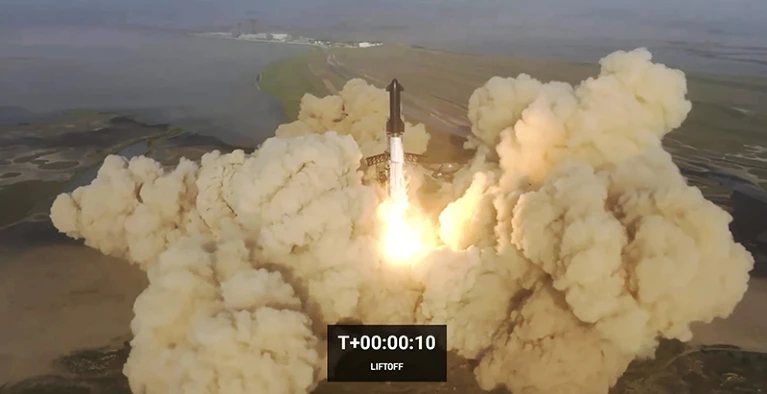
The enormous Starship roared off a launch pad in southern Texas today and then exploded before it reached space, ending the first major test flight of the largest rocket ever built. Starship and its booster cleared the launch pad and soared to 39 kilometres high, then rotated out of control and blew up four minutes into flight, before the two could separate as planned. “Obviously, this is not a nominal situation,” said John Insprucker, principal integration engineer for the company SpaceX, which built Starship, on a webcast of the launch attempt.
Still, the fact that it got off the launch pad, powered by up to 33 engines firing in synchrony, marks a substantial step beyond what SpaceX has been able to do so far with its most ambitious rocket. “Starship gave us a rather spectacular end to what was a truly incredible test,” Insprucker said later.
Future Starship flights are meant to kick off a new era of space exploration, including sending humans to the Moon and Mars, and could enable new types of astrophysics and planetary science. The rocket was uncrewed on this first test flight.
Most powerful rocket
Starship is nearly twice as powerful as NASA’s new deep-space rocket, the Space Launch System (SLS), which flew for the first time in November. Before today, Starship had flown in only a handful of relatively low-altitude tests above SpaceX’s spaceport location in Boca Chica, Texas. The goal of today’s flight had been to reach space and travel most of the way around the planet, and to splash down in the ocean off the coast of Hawaii.
If SpaceX demonstrates that Starship can reach orbit, that will be “significant for what it will bring afterwards”, says Laura Forczyk, executive director of Astralytical, a space consulting company in Atlanta, Georgia.
SpaceX wants to use Starship to colonize Mars. More immediately, NASA aims to use the vehicle to help put astronauts on the surface of the Moon in the coming years as part of its planned Artemis missions. And scientists are dreaming of how they might use Starship’s enormous size to carry big telescopes or planetary missions into deep space.
“We’re really excited about the prospect of enabling science with Starship,” Julianna Scheiman, SpaceX’s director of NASA satellite missions, said on 18 April at the Space Symposium in Colorado Springs, Colorado.
Reusable craft
Starship, which looks like a giant metal cylinder, sits 120 metres tall when stacked atop its Super Heavy rocket booster. The craft can carry up to 150 tonnes of equipment into space and is designed as a fully reusable transportation system. SpaceX plans to recover and reuse its parts to slash the cost of going to space.
“We have always been constrained in space flight by mass, volume and cost,” says Jennifer Heldmann, a planetary scientist at NASA’s Ames Research Center in Moffett Field, California. “And all of those constraints are basically lifted with Starship.”
NASA’s fleet of space shuttles, which flew 135 times to low Earth orbit and back between 1981 and 2011, was also supposed to provide frequent access to space. But NASA eventually retired the shuttle in favour of developing the more powerful SLS to travel farther away from Earth.
SpaceX has already developed smaller and partially reusable rockets, such as its Falcon 9 and Falcon Heavy series, that routinely launch satellites for governments, companies and other customers. It envisions using Starship to deploy even larger objects, such as the next generation of its Starlink communications satellites, which some astronomers have criticized for interfering with observations of the night sky.
Rocket challenges
It’s too soon to tell whether SpaceX can fulfil its promises of flying Starship regularly and cheaply, Forczyk says. But the fact that it has shown it can do so with smaller rockets, and that NASA is supporting Starship as a key part of its Moon exploration programme, are both in Starship’s favour.
Still, developing any new rocket is challenging, as today’s flight showed. SpaceX has a number of other Starships built and will likely test another one in the near future. “We could see a lot of significant progress this year,” Forczyk says. “Or not.”






